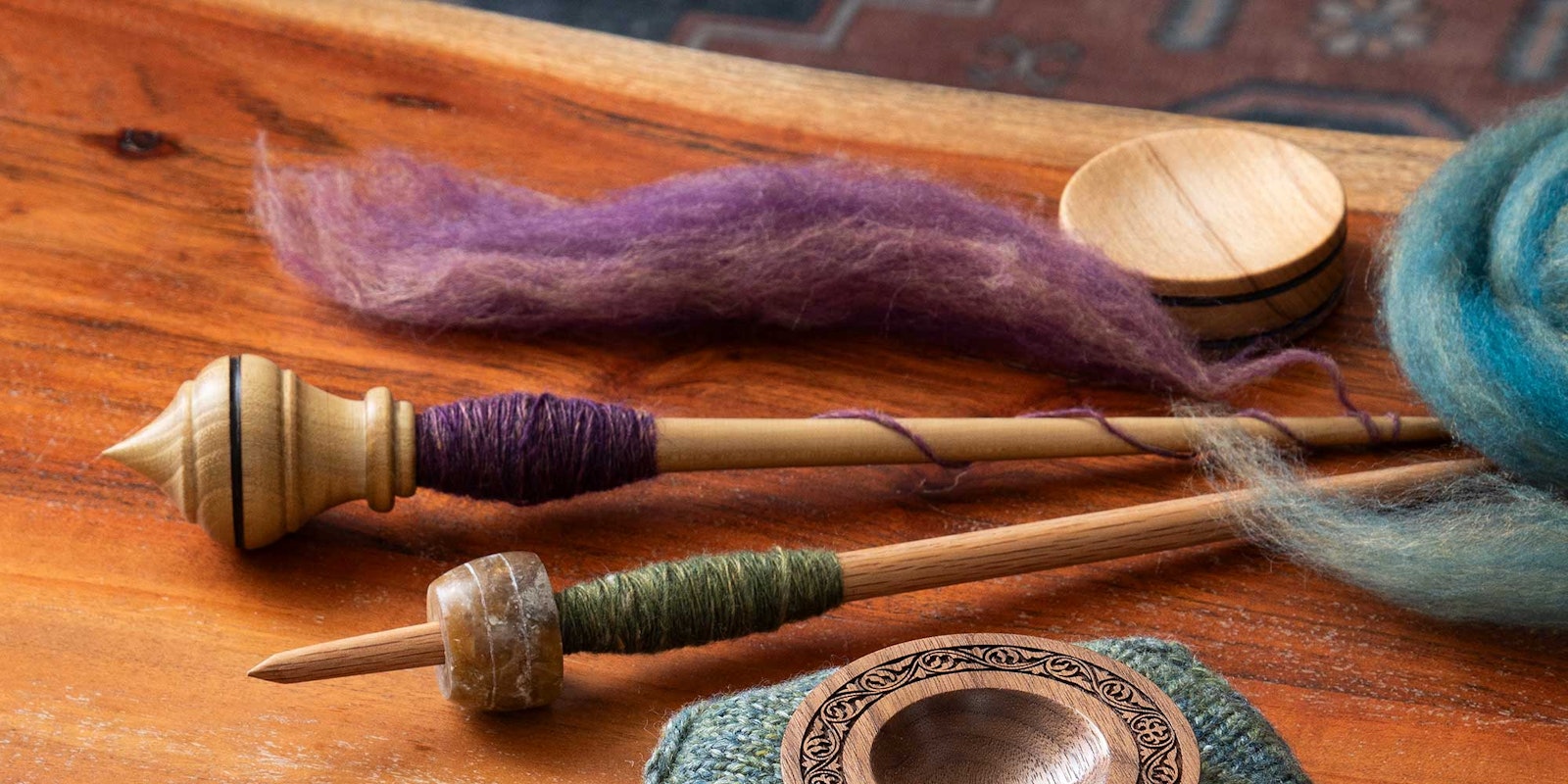Contents
In her 1995 Spin Off article “Spinning with a Supported Spindle,” Lynn DeRose Mason welcomes us into the world of supported spindles and discusses how these tools differ from suspended or “drop” spindles:
“A drop spindle is allowed to hang freely. Its weight tugs on the yarn being made, and that weight can be used to assist drafting. A supported spindle is supported by something—bowl, hand, foot, or ground. Its weight does not bear down on the yarn being spun. This makes it ideal for spinning very fine yarns or threads, because the newly drafted yarn need not be strong enough to support the weight of the spindle.”
To make fine, lofty yarns and make the most of luxury fibers, using a supported spindle will give you the most yardage per gram.
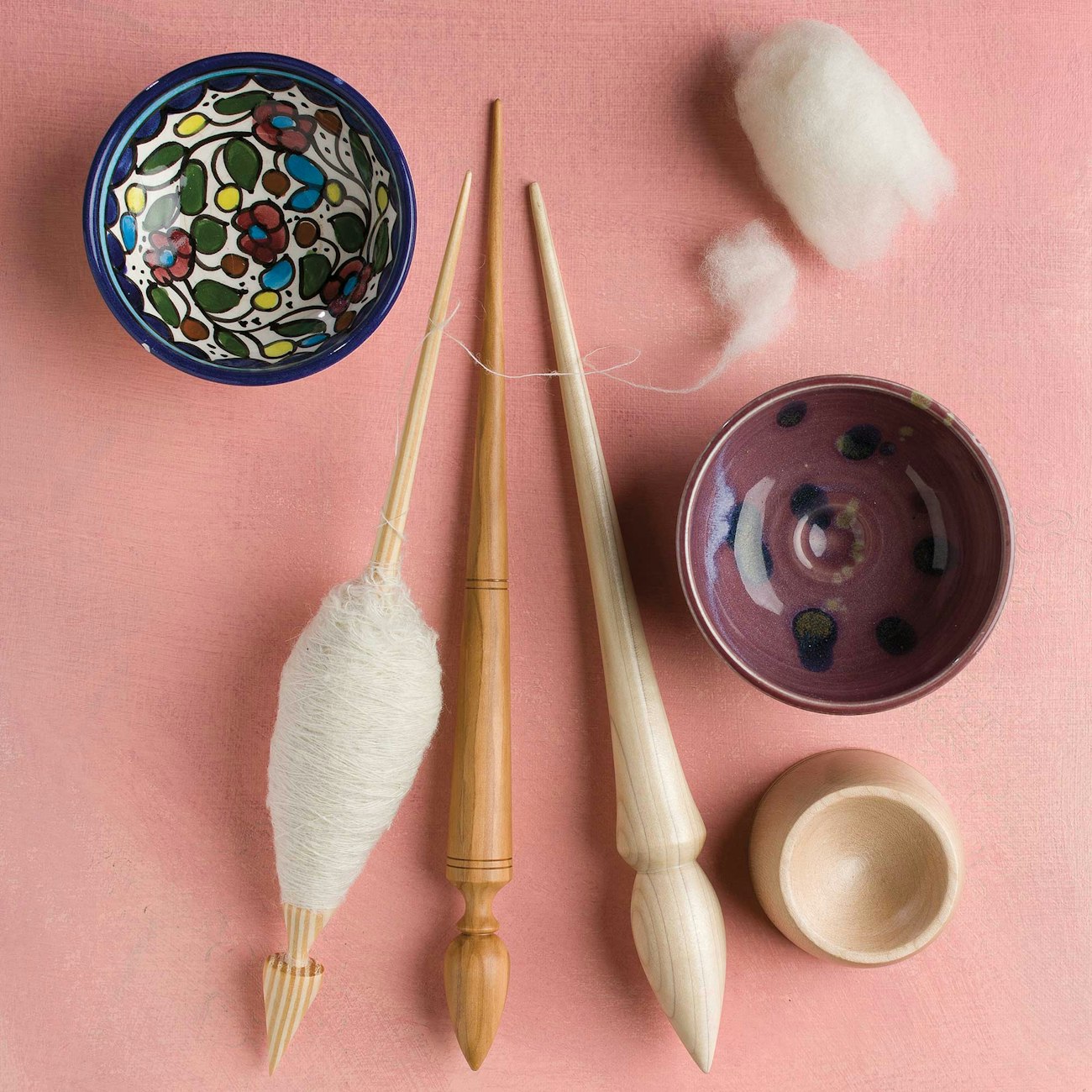 Russian-style supported spindles are distinctive in that they don’t have a whorl or a hook—the yarn is spun off the tip of the spindle. Use a bowl to support your spindle—the smoother the bowl, the faster the spindle will spin. Photo by Joe Coca
Russian-style supported spindles are distinctive in that they don’t have a whorl or a hook—the yarn is spun off the tip of the spindle. Use a bowl to support your spindle—the smoother the bowl, the faster the spindle will spin. Photo by Joe Coca
As Lynn explained, these spindles need to be supported by something. Handspinner and teacher Heavenly Bresser explores some different bowl options in her article “Spindle + Bowl: Finding the Perfect Pair.”
We’ve put together a collection of some of our favorite tips and techniques for working with the supported spindle, including an introduction to the many types of supported spindles, advice on how to get started—both with and without a leader—and how to ply your yarn. We hope you’ll give it a whirl!
Cheers!
—Spin Off editors
Get Started: 2 Methods
When starting with an empty spindle, you’ll need to secure the fiber to the spindle in some way to begin adding twist and drafting. There are many ways to solve this problem, and here are two common techniques. Both are great to know because, depending on the spindle and fiber combination, one might be a better fit than the other.
Using a Leader
Adapted from an article by Elise Cohen
A leader is something that is already spun that can be tied onto a spindle (or wheel bobbin) to get things started. It’s interesting to note that a leader can be a plied yarn or a singles, as Elise shows below:
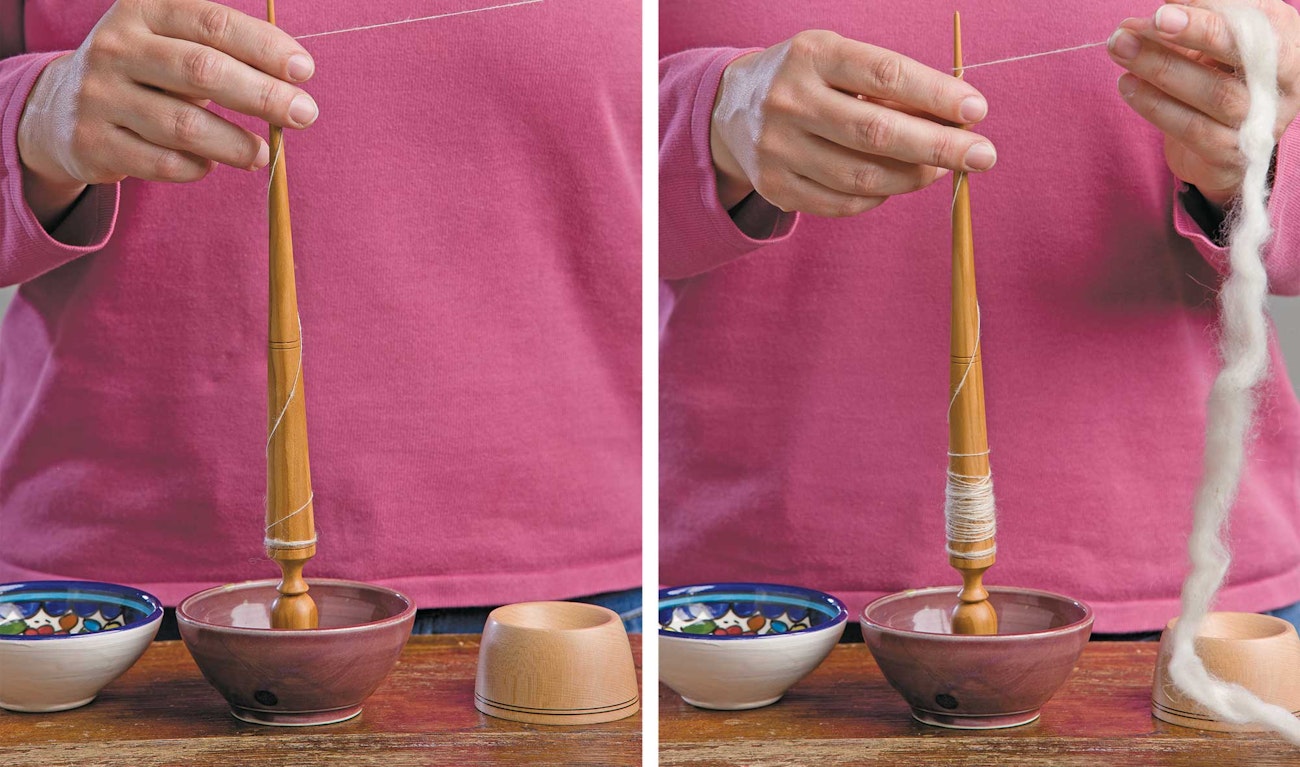 Left: Use a knot to attach a leader near the base of the spindle. Spin the spindle by the tip, winding the leader up the shaft as you go. Right: Hold your fiber perpendicular to the tip and draft backward with a long-draw technique. Photos by Joe Coca
Left: Use a knot to attach a leader near the base of the spindle. Spin the spindle by the tip, winding the leader up the shaft as you go. Right: Hold your fiber perpendicular to the tip and draft backward with a long-draw technique. Photos by Joe Coca
Knot your leader onto the shaft of the spindle above any thin neck or fancy turning. Wind it up the shaft, turning the spindle clockwise (for Z-twist), and spiraling it closer as it rises. Leave a few inches of leader loose at the top to attach your spinning fiber.
Hold a bit of fiber in your drafting hand and lay the last inch or so of the leader over it. Adjust your drafting hand to hold the leader with the fiber and use your spinning hand to spin the spindle from the tip, building up twist in the leader. Hold your drafting-and-fiber-control hand with the leader slightly above the spindle tip. Allow the built-up twist to enter the leader and through it—the fiber supply.
If you hold the fiber supply to the side of the tip (low angle) of the spindle instead of at the tip, then instead of adding twist to your fiber supply, the spinning spindle is just going to make the yarn wind onto the shaft. This may confuse you once or twice, but you’ll quickly get the hang of spinning off the tip.
Starting Without a Leader
Adapted from an article by Heather Zoppetti
You can also start spinning without the addition of a leader. Here’s how:
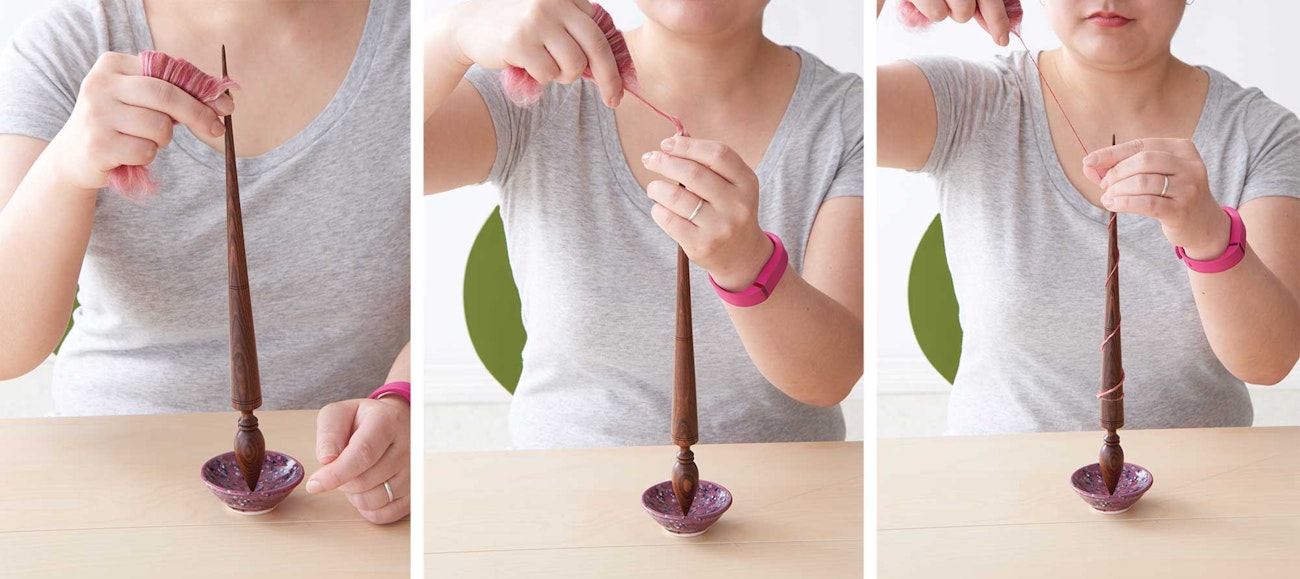 Left to right: Start spinning a leader by impaling the fiber over the tip of the spindle. Gently draft back with the fiber hand, add some twist, and repeat to build the leader. When the leader is long enough, slide it down the shaft and spiral it up to spin normally. Photos by Joe Coca/Donald Scott
Left to right: Start spinning a leader by impaling the fiber over the tip of the spindle. Gently draft back with the fiber hand, add some twist, and repeat to build the leader. When the leader is long enough, slide it down the shaft and spiral it up to spin normally. Photos by Joe Coca/Donald Scott
Getting started can be the hardest part of learning to spin with a supported spindle. Heather likes to spin her own leader, which she does by impaling the fiber over the tip and slowly drafting out some singles with a park-and-draft motion. To keep the fiber from jumping off the top of the spindle, Heather wets it just a bit, which helps it stick to the shaft while she builds up some twist. As she creates a longer singles, Heather slides the initial fiber down the shaft to the bottom. Once she has enough to wrap around and secure the initial fiber, she can start spinning as normal.
The Many Types of Supported Spindles
by Sukrita Mahon
Supported spindles can range from tiny and whorl-less to several feet long with a large, beautiful whorl; so much to learn and experience! Avid spinner and knitter Sukrita Mahon introduces you to several versions in her article “Supported Spindles: Pairing Fiber & Tool.”
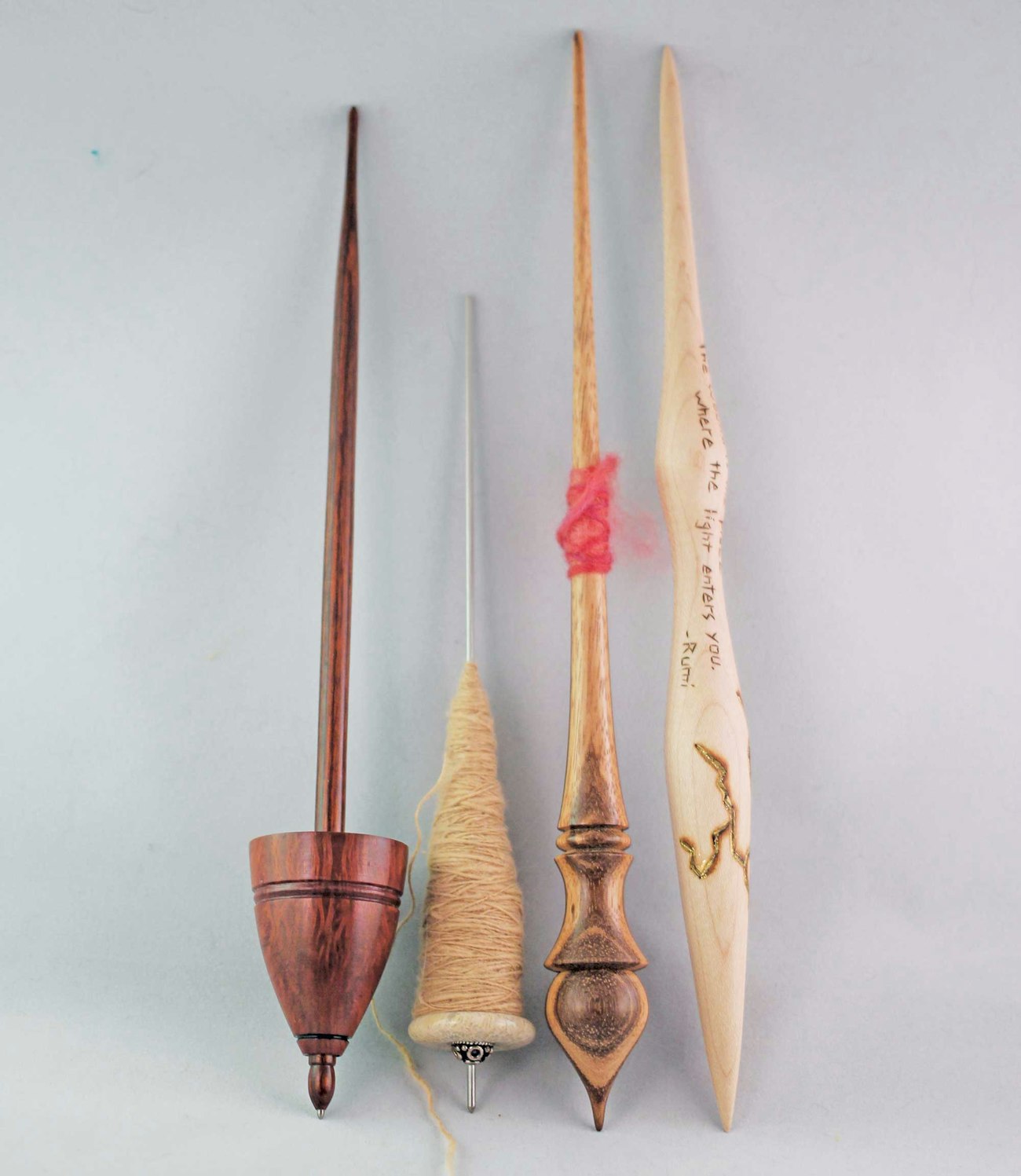 A few of Sukrita’s supported spindles; left to right: Tibetan-style, takli, Russian-style, and phang. Photo by Sukrita Mahon
A few of Sukrita’s supported spindles; left to right: Tibetan-style, takli, Russian-style, and phang. Photo by Sukrita Mahon
As Sukrita points out, “These spindles vary in size and shape across the world, depending greatly on what type of fiber and yarn they were made to spin. You will find that specific fibers are more easily spun with some types of spindles than others. Finding the combinations that work best for you can dramatically change the yarns you make and the enjoyment you find in creating them.”
Read the full article on the Spin Off website here.
Learn to Spin from the Fold
Spinning from the fold can be the key to comfortably spinning on the supported spindle. Heather Zoppetti explains, “When spinning supported, one hand is typically occupied with flicking and controlling the spindle, so a one-handed long draw is most commonly necessary. A long draw is best accomplished with a woolen or semiwoolen preparation. When using combed top, spinning from the fold can be especially helpful to control slippery fibers. Fold a small section of top over your index finger; the drafting zone comes off the center of the fiber mass. Spinning from the fold creates a semiwoolen yarn and is a good introduction to the long-draw method.”
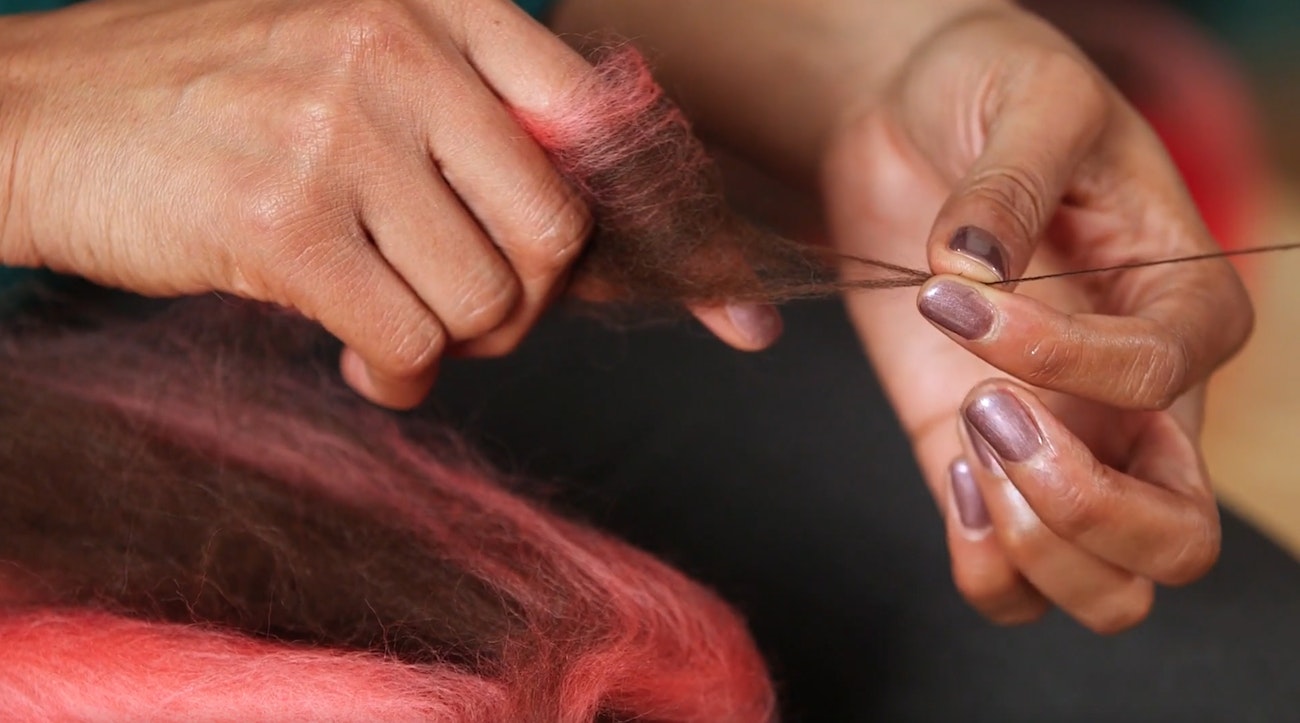 Heavenly Bresser demonstrates how to spin from the fold in her video course Spinning Fractal Yarns.
Heavenly Bresser demonstrates how to spin from the fold in her video course Spinning Fractal Yarns.
Check out these expert resources to help you learn to spin from the fold:
Maggie Casey explains why you would want to spin from the fold in her article “Spinning from the Fold: How to Spin Semiwoolen Yarn from Top.”
Then check out Heavenly Bresser’s tips for spinning from the fold, which also includes her instructions for how to split colorful combed tops for fractal spinning to help keep the colors clear by controlling which color and part of the fiber you want to draft next.
How Do I Finish?
Are you wondering how to ply your yarn that’s been spun using a supported spindle? You could ply off of this type of spindle like you would any other, but there are quite a few methods to choose from. Which method works best depends on the tool you plan to use for plying and whether you will be at home with all your tools or whether you need to be mobile.
We’ve created a guide to five common methods for removing singles from spindles for plying on a wheel or spindle.
Plying from spindles onto spindles takes some extra planning. Here’s what Deborah Held has to say:
Try to find a plying spindle “that’s heavier than the spindle(s) on which you spun your singles, even if only slightly. You’ll be able to add appropriate twist with less effort this way. And, since plied yarn is so much stronger than a singles yarn, this is a good time to enjoy some of those heavier spindles you’ve likely collected but don’t get to use.”
Galina Khmeleva has spent years sharing and teaching Orenburg lace. The YouTube video below provides a peek at Galina’s plying method for the fine yarns she spins on supported spindles. It’s quite different than other methods and helps us think about using the same tools in different ways.
We hope these tips and techniques inspire you to pull out some of your fiber blends and give a supported spindle a try.
Happy spinning!
Additional resources
Supported Spindle Spinning by Amelia Garripoli, video download
Meet Galina Khmeleva, an Inspired Spinner and Knitter, web article
Spinning Gossamer Threads: The Yarns of Orenburg with Galina Khmeleva, streaming video
3 Reasons to Choose Supported Spindles by Deborah Held, web article
Troubleshoot Your Takli Spindle by Kate Larson, web article
Akha Spindles: What Is the “Right” Way to Spin? by Kate Larson, web article
Twiza: Preparing and Spinning Wool in the Mountains of Morocco, video
You can also explore all the Spin Off videos that are part of your All Access subscription here on our streaming video site.

